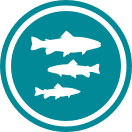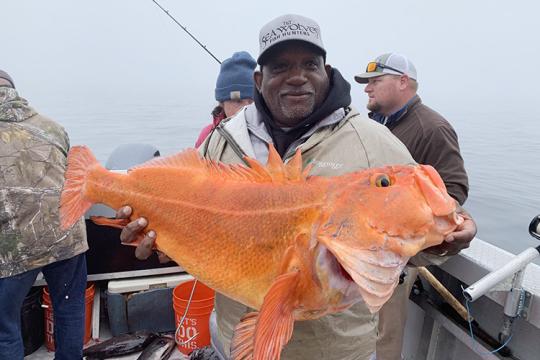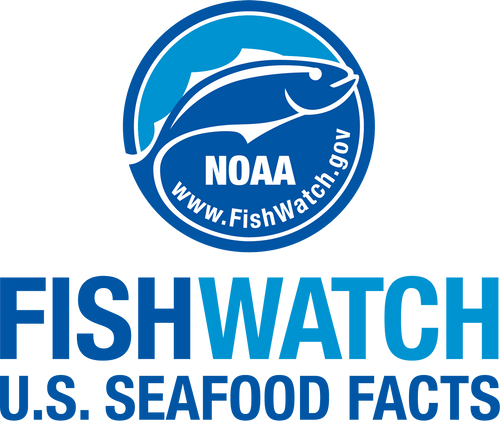 Big red snapper. Photo courtesy of Fish and Wildlife Research Institute
Big red snapper. Photo courtesy of Fish and Wildlife Research Institute
Big red snapper. Photo courtesy of Fish and Wildlife Research Institute
About the Species
 Big red snapper. Photo courtesy of Fish and Wildlife Research Institute
Big red snapper. Photo courtesy of Fish and Wildlife Research Institute
Big red snapper. Photo courtesy of Fish and Wildlife Research Institute
U.S. wild-caught red snapper is a smart seafood choice because it is sustainably managed under rebuilding plans that allow limited harvest by U.S. fishermen.

Population
The Gulf of Mexico stock is not overfished. The South Atlantic stock is overfished, but the fishing rate under a rebuilding plan promotes growth.

Fishing Rate
The Gulf of Mexico stock is not subject to overfishing. The South Atlantic stock is reduced to end overfishing.

Habitat Impact
Fishing gear used to harvest red snapper has minimal impacts on habitat.

Bycatch
Regulations require modified fishing gear to reduce bycatch. Release techniques improve the chance of survival of unintentionally caught fish.
Population Status
- There are two stocks of red snapper: The Gulf of Mexico stock and the South Atlantic stock. According to the most recent stock assessments:
- The Gulf of Mexico stock is not overfished but still rebuilding to target levels (2018 stock assessment), and not subject to overfishing based on 2023 catch data. Summary stock assessment information can be found on Stock SMART.
- The South Atlantic stock is overfished and subject to overfishing (2021 stock assessment). Summary stock assessment information can be found on Stock SMART.
Appearance
- Red snapper in deeper waters tend to be redder than those caught in shallower waters.
- They have a long triangular face with the upper part sloping more strongly than the lower.
- Their jaws are equal, with the lower one sometimes slightly projecting.
- They have enlarged canine teeth, which is why they are called “snappers.”
Biology
- Red snapper grow at a moderate rate, and may reach 40 inches long and 50 pounds.
- They can live a long time—red snapper as old as 57 years have been reported in the Gulf of America and as old as 51 years in the South Atlantic.
- Females are able to reproduce as early as age 2.
- Males and females spawn from May to October, depending on their location.
- Red snapper feed on fish, shrimp, crab, worms, cephalopods (octopus or squid), and some plankton (tiny floating plants and animals).
- Young red snapper are food for the large carnivorous fish that share their habitat, such as jacks, groupers, sharks, barracudas, and morays.
- Large marine mammals and turtles also eat snapper.
Where They Live
Range
- Red snapper are generally found at 30 to 620 feet deep in the Gulf of America (formerly Gulf of Mexico) and along the eastern coasts of North America, Central America, and northern South America.
- They are rare north of the Carolinas.
Habitat
- Larval red snapper swim freely within the water column.
- Juveniles live in shallow waters over sandy or muddy bottom habitat.
- Adults live on the bottom, usually near hard structures on the continental shelf that have moderate to high relief (for example, coral reefs, artificial reefs, rocks, ledges, and caves), sloping soft-bottom areas, and limestone deposits.
Fishery Management
- NOAA Fisheries with the Gulf of Mexico and South Atlantic Fishery Management Councils manage red snapper in the United States.
- In the Gulf of America, managed under the Fishery Management Plan for the Reef Fish Resources of the Gulf of Mexico:
- A rebuilding plan was implemented in 2005 with the goal of rebuilding the Gulf of Mexico red snapper stock by 2032.
- Annual catch limits for the commercial and recreational fisheries.
- Commercial fishermen must have a permit to harvest red snapper. Through the individual fishing quota (catch shares) program, they may harvest their quotas whenever they choose and must report how much they harvest.
- A minimum size limit protects the spawning stock and juveniles.
- For more information, visit NOAA Fisheries Southeast Regional Office’s Gulf of Mexico Red Snapper Management website.
- In the South Atlantic, managed under the Fishery Management Plan for the Snapper-Grouper Fishery of the South Atlantic Region:
- A rebuilding plan was implemented in 2010 with the goal of rebuilding the South Atlantic red snapper stock by 2044. It allows for limited harvest of red snapper as the population continues to grow.
- In 2010 and 2011, regulations prohibited harvest of red snapper in the South Atlantic to protect the population from too much fishing pressure and to allow the number of fish to increase.
- Limited harvest was allowed in 2012-2014. Harvest was prohibited in 2015 and 2016.
- For more information, visit the South Atlantic Fishery Management Council’s Red Snapper Regulations website or NOAA Fisheries Southeast Regional Office’s South Atlantic Snapper-Grouper Management page.
- State management consistency with federal management
- In the Gulf of America, recreational state management measures are very different from recreational federal management measures.
- In the South Atlantic, state management measures are fairly consistent with the federal management measures noted above. Some states, such as South Carolina and Georgia, automatically adopt federal regulations while others have separate regulations.
Harvest
- Commercial sector:
- In 2023, commercial landings of red snapper totaled approximately 8.3 million pounds and were valued at $43 million, according to the NOAA Fisheries commercial fishing landings database.
- Gear types, habitat impacts, and bycatch:
- Commercial fishermen mainly use hook-and-line gear (handlines and electric reels) to harvest red snapper, and sometimes use longlines (in the Gulf of America) and spears.
- Commercial fishermen using hook and line gear attach multiple hooks to a vertical line and weight it at the bottom.
- Recreational anglers primarily use hook and line gear to harvest red snapper.
- Fishermen are encouraged to use venting tools and recompression devices when releasing fish suffering from barotrauma. Barotrauma occurs when the swim bladder of a fish expands as it is quickly brought to the surface. Venting tools help deflate the swim bladder and recompression devices help the fish return to the depth at which it was caught to recompress the air in the swim bladder, preventing serious injury to the fish.
- In the Gulf of America:
- Regulations prohibit fishing in certain areas of the Gulf of America to protect sensitive fish populations and habitats.
- Measures are in place to reduce sea turtle bycatch by longline gear and include limiting times or areas where fishermen can fish, gear restrictions, and a limit on the number of vessels that can participate in the reef fish fishery. In addition, all commercial fishermen must follow special sea turtle release protocols and have specialized gear to improve the chances of incidentally caught sea turtles to survive.
- In the South Atlantic:
- Circle hooks are required when fishing for snapper and grouper species north of latitude 28° N. De-hooking devices are also required in the South Atlantic for snapper-grouper species.
- Measures are in place to reduce sea turtle bycatch by fishing gear and include gear restrictions and handling requirements, and a limit on the number of vessels that can participate in the snapper-grouper fishery.
- Recreational sector:
- Recreational anglers primarily use hook and line gear to harvest red snapper.
- In 2023, recreational anglers landed 14.6 million pounds of red snapper, according to the NOAA Fisheries recreational fishing landings database.
- In the Gulf of America:
- Red snapper must be a minimum size to be caught, and there is a limit on how many red snapper anglers can keep per day.
- Charter vessels and headboats must have a permit to fish in federal waters.
- For-hire vessels must use specialized gear and follow certain sea turtle release protocols.
- In the South Atlantic:
- In 2012, 2013, and 2014 the red snapper season was limited.
- In 2010–2011 and 2015–2016, the red snapper fishery was closed.
Scientific Classification
- Red snapper are generally found at 30 to 620 feet deep in the Gulf of America (formerly Gulf of Mexico) and along the eastern coasts of North America, Central America, and northern South America.
- They are rare north of the Carolinas.
- Larval red snapper swim freely within the water column.
- Juveniles live in shallow waters over sandy or muddy bottom habitat.
- Adults live on the bottom, usually near hard structures on the continental shelf that have moderate to high relief (for example, coral reefs, artificial reefs, rocks, ledges, and caves), sloping soft-bottom areas, and limestone deposits.
Fishery Management
- NOAA Fisheries with the Gulf of Mexico and South Atlantic Fishery Management Councils manage red snapper in the United States.
- In the Gulf of America, managed under the Fishery Management Plan for the Reef Fish Resources of the Gulf of Mexico:
- A rebuilding plan was implemented in 2005 with the goal of rebuilding the Gulf of Mexico red snapper stock by 2032.
- Annual catch limits for the commercial and recreational fisheries.
- Commercial fishermen must have a permit to harvest red snapper. Through the individual fishing quota (catch shares) program, they may harvest their quotas whenever they choose and must report how much they harvest.
- A minimum size limit protects the spawning stock and juveniles.
- For more information, visit NOAA Fisheries Southeast Regional Office’s Gulf of Mexico Red Snapper Management website.
- In the South Atlantic, managed under the Fishery Management Plan for the Snapper-Grouper Fishery of the South Atlantic Region:
- A rebuilding plan was implemented in 2010 with the goal of rebuilding the South Atlantic red snapper stock by 2044. It allows for limited harvest of red snapper as the population continues to grow.
- In 2010 and 2011, regulations prohibited harvest of red snapper in the South Atlantic to protect the population from too much fishing pressure and to allow the number of fish to increase.
- Limited harvest was allowed in 2012-2014. Harvest was prohibited in 2015 and 2016.
- For more information, visit the South Atlantic Fishery Management Council’s Red Snapper Regulations website or NOAA Fisheries Southeast Regional Office’s South Atlantic Snapper-Grouper Management page.
- State management consistency with federal management
- In the Gulf of America, recreational state management measures are very different from recreational federal management measures.
- In the South Atlantic, state management measures are fairly consistent with the federal management measures noted above. Some states, such as South Carolina and Georgia, automatically adopt federal regulations while others have separate regulations.
Harvest
- Commercial sector:
- In 2023, commercial landings of red snapper totaled approximately 8.3 million pounds and were valued at $43 million, according to the NOAA Fisheries commercial fishing landings database.
- Gear types, habitat impacts, and bycatch:
- Commercial fishermen mainly use hook-and-line gear (handlines and electric reels) to harvest red snapper, and sometimes use longlines (in the Gulf of America) and spears.
- Commercial fishermen using hook and line gear attach multiple hooks to a vertical line and weight it at the bottom.
- Recreational anglers primarily use hook and line gear to harvest red snapper.
- Fishermen are encouraged to use venting tools and recompression devices when releasing fish suffering from barotrauma. Barotrauma occurs when the swim bladder of a fish expands as it is quickly brought to the surface. Venting tools help deflate the swim bladder and recompression devices help the fish return to the depth at which it was caught to recompress the air in the swim bladder, preventing serious injury to the fish.
- In the Gulf of America:
- Regulations prohibit fishing in certain areas of the Gulf of America to protect sensitive fish populations and habitats.
- Measures are in place to reduce sea turtle bycatch by longline gear and include limiting times or areas where fishermen can fish, gear restrictions, and a limit on the number of vessels that can participate in the reef fish fishery. In addition, all commercial fishermen must follow special sea turtle release protocols and have specialized gear to improve the chances of incidentally caught sea turtles to survive.
- In the South Atlantic:
- Circle hooks are required when fishing for snapper and grouper species north of latitude 28° N. De-hooking devices are also required in the South Atlantic for snapper-grouper species.
- Measures are in place to reduce sea turtle bycatch by fishing gear and include gear restrictions and handling requirements, and a limit on the number of vessels that can participate in the snapper-grouper fishery.
- Recreational sector:
- Recreational anglers primarily use hook and line gear to harvest red snapper.
- In 2023, recreational anglers landed 14.6 million pounds of red snapper, according to the NOAA Fisheries recreational fishing landings database.
- In the Gulf of America:
- Red snapper must be a minimum size to be caught, and there is a limit on how many red snapper anglers can keep per day.
- Charter vessels and headboats must have a permit to fish in federal waters.
- For-hire vessels must use specialized gear and follow certain sea turtle release protocols.
- In the South Atlantic:
- In 2012, 2013, and 2014 the red snapper season was limited.
- In 2010–2011 and 2015–2016, the red snapper fishery was closed.
Scientific Classification
| Kingdom | Animalia | Phylum | Chordata | Class | Actinopterygii | Order | Perciformes | Family | Lutjanidae | Genus | Lutjanus | Species | campechanus |
|---|
Last updated by NOAA Fisheries on 03/10/2025
Featured News

 On Oct. 8, 2024, at 6:30 p.m. EDT, NOAA’s GOES East satellite captured this imagery of Hurricane Milton approaching the Gulf Coast of Florida. At its most powerful, Milton’s maximum sustained winds reached 180 mph making the storm an extremely dangerous Category 5 hurricane.
On Oct. 8, 2024, at 6:30 p.m. EDT, NOAA’s GOES East satellite captured this imagery of Hurricane Milton approaching the Gulf Coast of Florida. At its most powerful, Milton’s maximum sustained winds reached 180 mph making the storm an extremely dangerous Category 5 hurricane.
How the 2024 Hurricane Season Impacted Recreational Fishing in the Gulf of Mexico
 NOAA Officers on a charter patrol off the west coast of Florida. Credit: NOAA Fisheries
NOAA Officers on a charter patrol off the west coast of Florida. Credit: NOAA Fisheries
 Credit: Florida Sea Grant
Credit: Florida Sea Grant
Seafood Facts

Is Red Snapper Sustainable?
U.S. wild-caught red snapper is a smart seafood choice because it is sustainably managed under rebuilding plans that allow limited harvest by U.S. fishermen.
Availability
U.S. wild-caught red snapper is available fresh year-round.
Source
U.S. wild-caught from North Carolina to Texas.
Taste
Red snapper has a sweetly mild but distinctive flavor.
Texture
Red snapper is semi-firm, lean, and moist.
Color
The meat is pinkish with yellow tones when raw and turns somewhat lighter when cooked. Red snapper have trademark red skin and red eyes and come from domestic fisheries. To aid in identification, they are usually sold with the skin on.
Health Benefits
Red snapper is low in saturated fat and sodium and is a very good source of protein.
Nutrition Facts
Servings: 1; Serving Weight: 100 g (raw); Calories: 100; Protein: 20.51 g; Total Fat: 1.34 g; Total Saturated Fatty Acids: 0.285 g; Carbohydrate: 0 g; Total Sugars: 0 g; Total Dietary Fiber: 0 g; Cholesterol: 37 mg; Selenium: 38.2 mcg; Sodium: 64 mgMore Information
Last updated by NOAA Fisheries on 03/10/2025
Seafood News
 Chef Tyler Hadfield’s Curried Skate Wings with Tomato-Masala Chutney
Chef Tyler Hadfield’s Curried Skate Wings with Tomato-Masala Chutney
Ring In the New Year With These Crowd-Favorite Seafood Recipes
 NOAA Fisheries, in collaboration with Blue Ocean Mariculture, is conducting a multi-year pilot study to evaluate observational methods and tools for studying Hawaiian monk seal behavior. Courtesy of Blue Ocean Mariculture
NOAA Fisheries, in collaboration with Blue Ocean Mariculture, is conducting a multi-year pilot study to evaluate observational methods and tools for studying Hawaiian monk seal behavior. Courtesy of Blue Ocean Mariculture
AI Meets Aquaculture to Study Hawaiian Monk Seal Interactions With Net Pens
 Tonya Wick aboard a fishing vessel at sea in 1998. Photo courtesy of Tonya Wick
Tonya Wick aboard a fishing vessel at sea in 1998. Photo courtesy of Tonya Wick
 Fish on display at the market. Credit: Shutterstock
Fish on display at the market. Credit: Shutterstock
Documents
Red Snapper Recreational Discard Data Quality Improvement Workshop Report
This report details the background, technologies, and conclusions discussed at the second IRA…
Recreational Fishing Effort Estimation Improvement Workshop Report
This report details the background, technologies, and conclusions discussed at the first Inflation…
Southeast Otter Trawl and Reef Fish Fisheries Observer Materials
For the Characterization of the U.S. Gulf of Mexico and Southeastern Atlantic Otter Trawl and…
2020 Gulf of Mexico Red Snapper Recreational Season Length Estimates for the Federal For-Hire Component
The purpose of this report is to project the 2020 recreational red snapper federal for-hire fishing…
Data & Maps
Research
Discard Mortality of Red Snapper Released with Descender Devices in the U.S. South Atlantic
Increased use of descender devices will reduce discard mortality for Red Snapper, enhancing efforts…
Source–sink recruitment of red snapper: Connectivity between the Gulf of Mexico and Atlantic Ocean
We use a biophysical modeling approach to simulate recruitment of red snapper across the entire…
No Butts About It: Using Urogenital Disparity in a Deep-Water Snapper, Etelis carbunculus (Lutjanidae), for Field-Based Sexual Identification
Using a non-invasive method to consistently identified sex based differences in the length and…
Environmental Conditions, Diel Period, and Fish Size Influence the Horizontal and Vertical Movements of Red Snapper
Our results have implications for scientific surveys of red snapper used for population assessment…
Outreach & Education
NOAA Fisheries and Gulf State Recreational Fishing Data Collection Handout
This handout explains how NOAA Fisheries supports the development and implementation of Gulf state…
Approved Models and Equipment for Careful Release of Sea Turtles Caught in Gulf of Mexico Reef Fish Fishery and South Atlantic Snapper Grouper Fishery
Information to help fishermen comply with sea turtle release requirements contained in regulations…
Frequent Questions: Landing Federally-Managed Reef Fish Commercially Harvested from Gulf of Mexico Federal Waters
Last Updated: March 2019
Last updated by NOAA Fisheries on 03/10/2025





